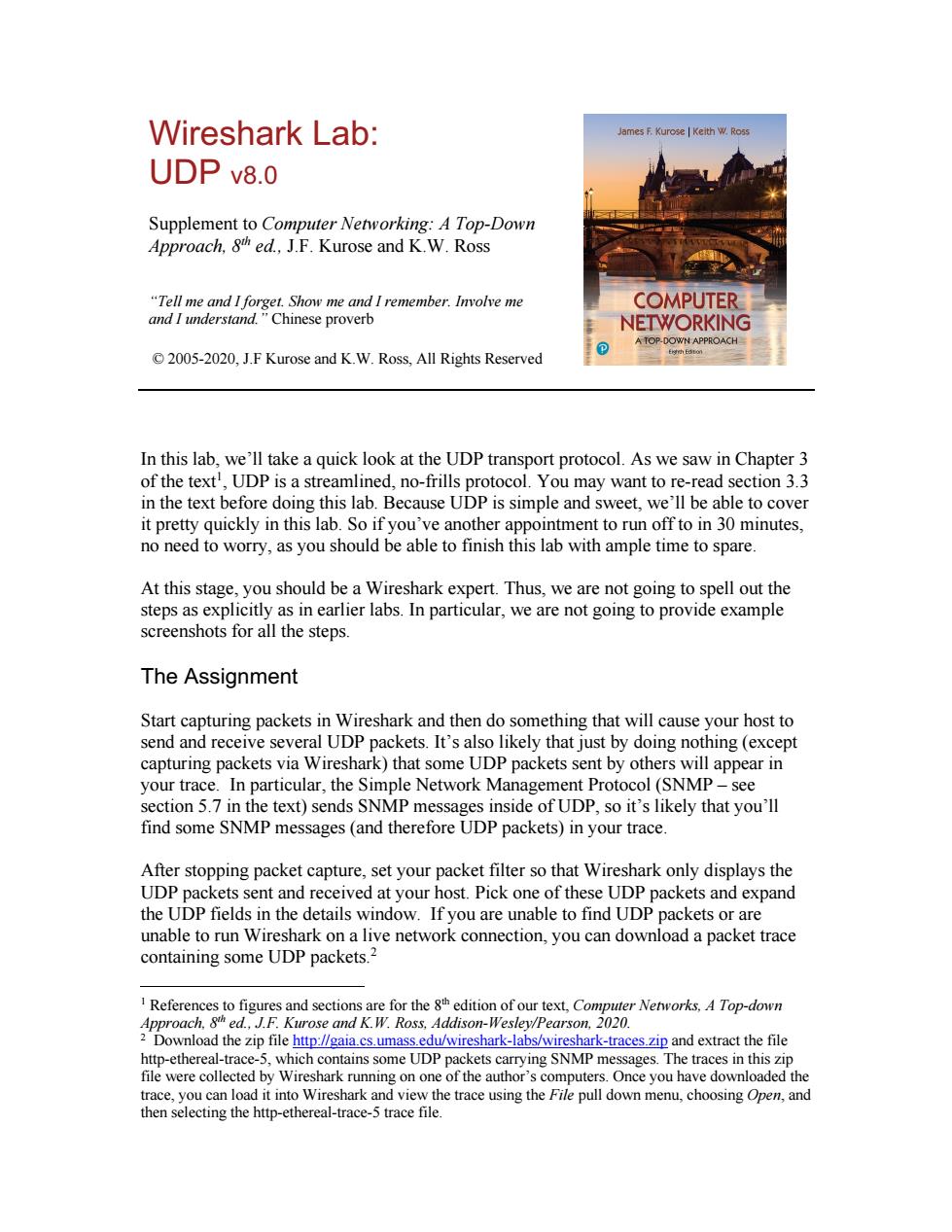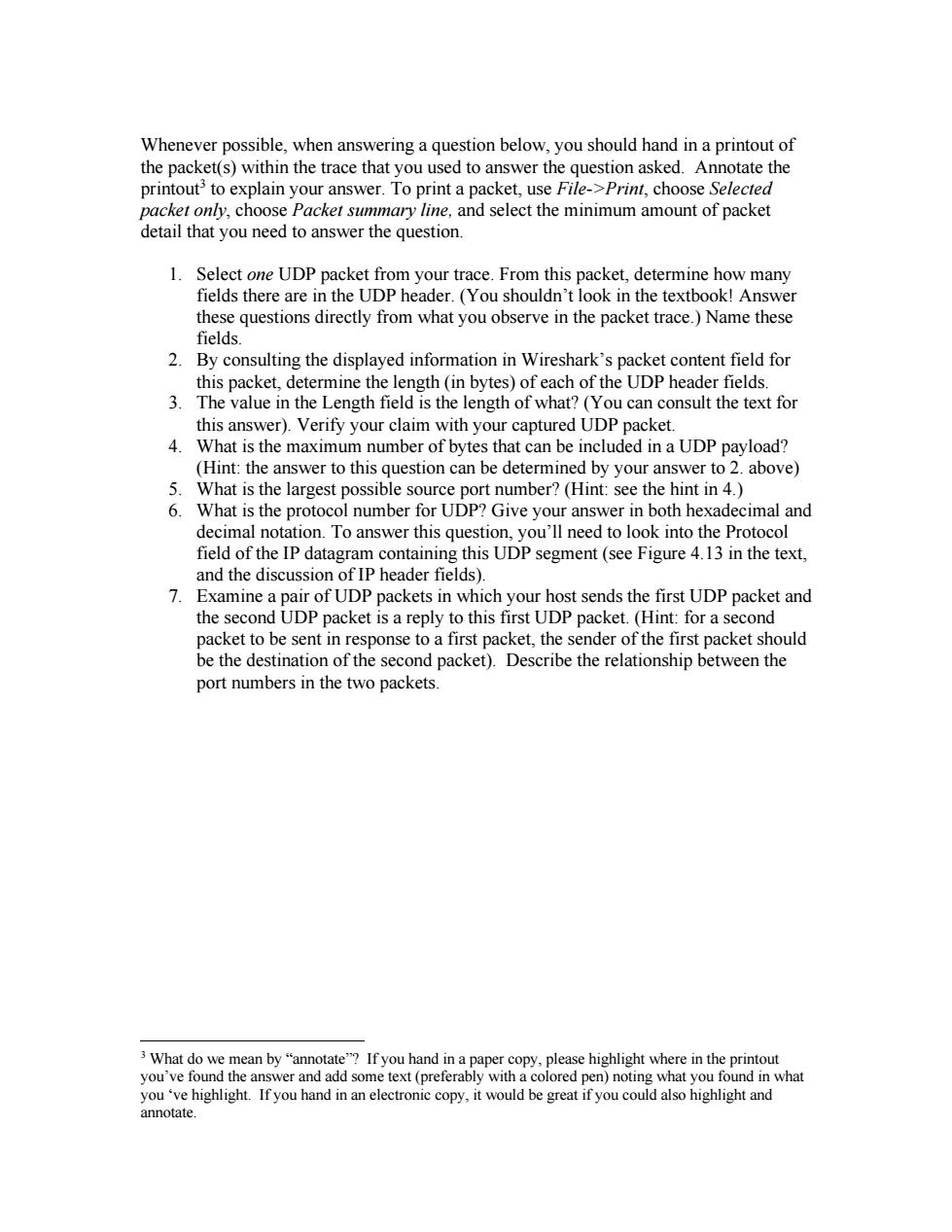
Wireshark Lab: nes F.Kurose I Keithw.Ros UDP v8.0 Supplement to Computer Networking:A Top-Down Approach,8h ed..J.F.Kurose and K.W.Ross COMPUTER NETWORKING 2005-2020.J.F Kurose and K.W.Ross.All Rights Reserved D In this lab,we'll take a quick look at the UDP transport protocol.As we saw in Chapter 3 of the text,UDP is a streamlined,no-frills protocol.You may want to re-read section 3.3 in the text before doing this lab.Because UDP is simple and sweet,we'll be able to cover it pretty quickly in this lab.So if you've another appointment to run off to in 30 minutes, no need to worry,as you should be able to finish this lab with ample time to spare. At this stage,you should be a Wireshark expert.Thus,we are not going to spell out the steps as explicitly as in earlier labs.In particular,we are not going to provide example screenshots for all the steps. The Assignment Start capturing packets in Wireshark and then do something that will cause your host to send and receive several UDP packets.It's also likely that just by doing nothing(except capturing packets via Wireshark)that some UDP packets sent by others will appear in your trace.In particular,the Simple Network Management Protocol(SNMP-see section 5.7 in the text)sends SNMP messages inside of UDP,so it's likely that you'll find some SNMP messages(and therefore UDP packets)in your trace. After stopping packet capture,set your packet filter so that Wireshark only displays the UDP packets ent and re e network onnect ning some UDP ion,you can download a packetrac heeomNorTop-do ood th shark-labsbireshark es zip and ex tract the file http-ethereal-trace-5.which contains some UDP packets carrying SNMP messages.The traces in thiszip Wire shar ing on one of the author Once you have downloaded th e pu trace. 5 trace file. wn menu,choosing Open,and
Wireshark Lab: UDP v8.0 Supplement to Computer Networking: A Top-Down Approach, 8th ed., J.F. Kurose and K.W. Ross “Tell me and I forget. Show me and I remember. Involve me and I understand.” Chinese proverb © 2005-2020, J.F Kurose and K.W. Ross, All Rights Reserved In this lab, we’ll take a quick look at the UDP transport protocol. As we saw in Chapter 3 of the text1 , UDP is a streamlined, no-frills protocol. You may want to re-read section 3.3 in the text before doing this lab. Because UDP is simple and sweet, we’ll be able to cover it pretty quickly in this lab. So if you’ve another appointment to run off to in 30 minutes, no need to worry, as you should be able to finish this lab with ample time to spare. At this stage, you should be a Wireshark expert. Thus, we are not going to spell out the steps as explicitly as in earlier labs. In particular, we are not going to provide example screenshots for all the steps. The Assignment Start capturing packets in Wireshark and then do something that will cause your host to send and receive several UDP packets. It’s also likely that just by doing nothing (except capturing packets via Wireshark) that some UDP packets sent by others will appear in your trace. In particular, the Simple Network Management Protocol (SNMP – see section 5.7 in the text) sends SNMP messages inside of UDP, so it’s likely that you’ll find some SNMP messages (and therefore UDP packets) in your trace. After stopping packet capture, set your packet filter so that Wireshark only displays the UDP packets sent and received at your host. Pick one of these UDP packets and expand the UDP fields in the details window. If you are unable to find UDP packets or are unable to run Wireshark on a live network connection, you can download a packet trace containing some UDP packets.2 1 References to figures and sections are for the 8th edition of our text, Computer Networks, A Top-down Approach, 8th ed., J.F. Kurose and K.W. Ross, Addison-Wesley/Pearson, 2020. 2 Download the zip file http://gaia.cs.umass.edu/wireshark-labs/wireshark-traces.zip and extract the file http-ethereal-trace-5, which contains some UDP packets carrying SNMP messages. The traces in this zip file were collected by Wireshark running on one of the author’s computers. Once you have downloaded the trace, you can load it into Wireshark and view the trace using the File pull down menu, choosing Open, and then selecting the http-ethereal-trace-5 trace file

Whenever possible,when answering a question below,you should hand in a printout of the packet(s)within the trace that you used to answer the question asked.Annotate the printout to explain your answer.To print a packet,use File->Print,choose Selected packet only,choose Packet summary line.and select the minimum amount of packet detail that you need to answer the question 1. Select one UDP packet from your trace.From this packet,determine how many fields ther the udp (You sl uldn't look in the textbook!An uestions di ectly from what you in the pa ke trace.)Name these ields 2. By consulting the displayed info rmation in Wireshark's ket con ent field for ength (in bytes)of each o th UDP hea fields 3. ne ength fi is the length of what ou can consult the text for this answer).Verify your claim with your captured UDP packet. What is the maximum number of bytes that can be included in a UDP payload? (Hint:the answer to this question can be determined by your answer to 2.above) 5. What is the largest possible source port number?(Hint:see the hint in 4.) 6.What is the protocol number for UDP?Give your answer in both hexadecimal and decimal notation.To answer this question,you'll need to look into the Protocol field of the IP datagram containing this UDP segment(see Figure 4.13 in the text, and the discussion of ip header fields) 7.Examine a pair of UDP packets in which your host sends the first UDP packet and the second UDP packet is a reply to this first UDP packet.(Hint:for a second packet to be sent in response to a first packet,the s nder of the first packet should be the destination of the second packet).Describe the relationship between the port numbers in the two packets 3 What do we an by"an e highlight where in the you've found the ans you've highlight.If you hand in an electronic copy,it would be great if you could also highlight and
Whenever possible, when answering a question below, you should hand in a printout of the packet(s) within the trace that you used to answer the question asked. Annotate the printout3 to explain your answer. To print a packet, use File->Print, choose Selected packet only, choose Packet summary line, and select the minimum amount of packet detail that you need to answer the question. 1. Select one UDP packet from your trace. From this packet, determine how many fields there are in the UDP header. (You shouldn’t look in the textbook! Answer these questions directly from what you observe in the packet trace.) Name these fields. 2. By consulting the displayed information in Wireshark’s packet content field for this packet, determine the length (in bytes) of each of the UDP header fields. 3. The value in the Length field is the length of what? (You can consult the text for this answer). Verify your claim with your captured UDP packet. 4. What is the maximum number of bytes that can be included in a UDP payload? (Hint: the answer to this question can be determined by your answer to 2. above) 5. What is the largest possible source port number? (Hint: see the hint in 4.) 6. What is the protocol number for UDP? Give your answer in both hexadecimal and decimal notation. To answer this question, you’ll need to look into the Protocol field of the IP datagram containing this UDP segment (see Figure 4.13 in the text, and the discussion of IP header fields). 7. Examine a pair of UDP packets in which your host sends the first UDP packet and the second UDP packet is a reply to this first UDP packet. (Hint: for a second packet to be sent in response to a first packet, the sender of the first packet should be the destination of the second packet). Describe the relationship between the port numbers in the two packets. 3 What do we mean by “annotate”? If you hand in a paper copy, please highlight where in the printout you’ve found the answer and add some text (preferably with a colored pen) noting what you found in what you ‘ve highlight. If you hand in an electronic copy, it would be great if you could also highlight and annotate